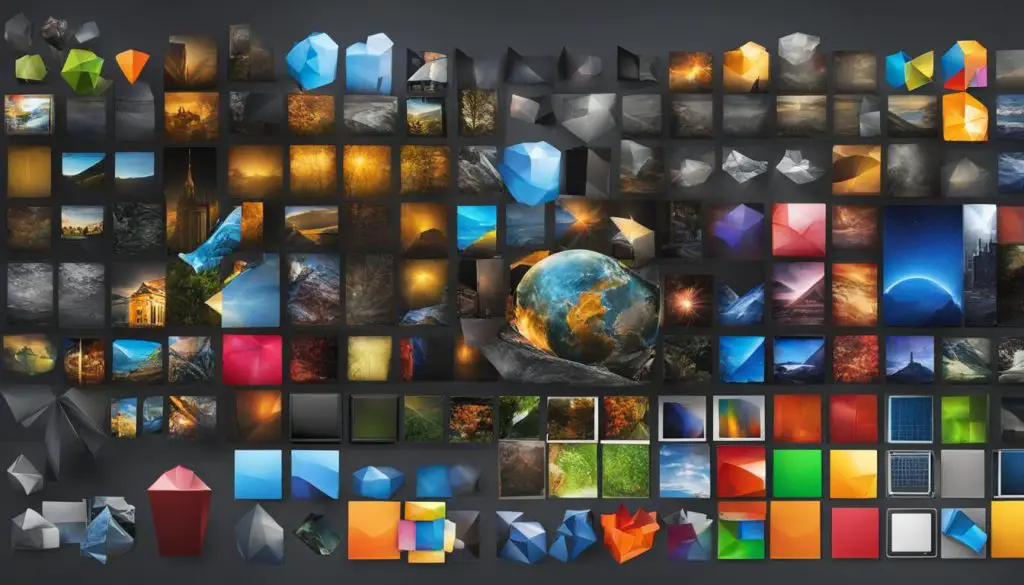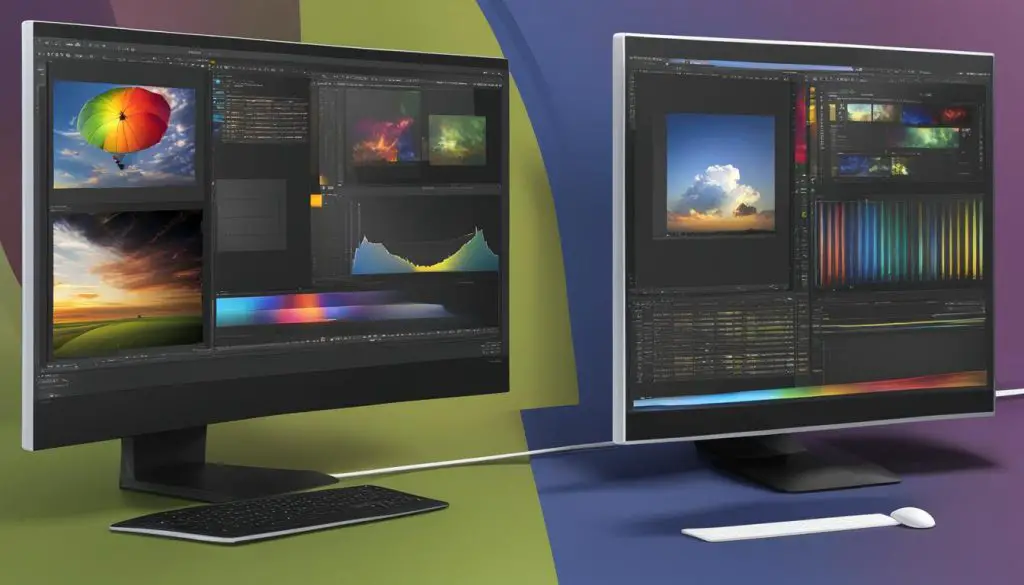
In GIMP, understanding the file formats is essential for efficient image saving and manipulation. Among the various file types available, it’s crucial to know which file type saves paths in GIMP. This comprehensive guide will provide you with all the information you need to make informed decisions when saving your images.
Key Takeaways:
- GIMP offers multiple file formats for saving images, each with its own advantages and limitations.
- The XCF format is the native GIMP image format and saves everything, including paths, layers, selections, and channels.
- JPG is commonly used for displaying photography, but it is a lossy format that may slightly alter the image data with repeated editing.
- PNG is a lossless format with support for transparency, making it ideal for web page graphics and computer graphics.
- GIF is primarily used for small animated images and is universally supported.
Understanding GIMP’s File Formats
When working with GIMP, it is essential to understand the various file formats available for saving your images. Each format has its own advantages and limitations, so choosing the right one depends on your specific needs and preferences.
The native GIMP image format is XCF, which stands for eXperimental Computing Facility. XCF files preserve all aspects of an image, including layers, selections, channels, and paths. However, XCF files tend to be quite large and are not suitable for display purposes.
If you are looking to display your images or share them with others, the JPG format is a common option. JPG files are compressed and are universally supported for display and storage of photography. Keep in mind that JPG is a lossy format, meaning that repeated editing can slightly degrade image quality over time.
Other file formats that can save paths in GIMP include PNG, GIF, TIFF, and raw image formats. PNG is a lossless format that supports partial transparency, making it ideal for web page graphics. GIF, on the other hand, is universally supported for animations. TIFF and raw image formats are recommended for storage and exchange of high-quality images.
| File Format | Advantages | Limitations |
|---|---|---|
| XCF | Preserves all image components | Bulky and not meant for display purposes |
| JPG | Universally supported for display and storage of photography | Lossy format, repeated editing can degrade image quality |
| PNG | Lossless format, supports partial transparency | Large file sizes, not ideal for complex images |
| GIF | Universally supported for animations | Limited color palette, not suitable for high-quality images |
| TIFF | Recommended for storage and exchange of high-quality images | Large file sizes |
| Raw | Preserves the original image data, ideal for professional photographers | Requires specialized software for editing and processing |
Saving Paths in GIMP
In GIMP, paths are a powerful tool that allows users to create precise selections, design vector-based graphics, and apply various effects to specific areas of an image. To effectively work with paths in GIMP, it’s important to understand how to save and retrieve them.
Saving Paths in GIMP
To save paths in GIMP, you can use the “Save as” command. This command allows you to specify the desired file format and location for saving the image along with its paths. It is recommended to use GIMP’s native XCF format if you want to preserve all components of the image, including the paths. However, keep in mind that XCF files are not meant for display purposes and can be quite bulky.
If you need to display the image or share it with others, you can choose alternative file formats such as JPG, PNG, or GIF. These formats are widely supported and offer different advantages based on your specific requirements. JPG, for example, is commonly used for displaying photography as it efficiently compresses files. PNG, on the other hand, is a lossless format that supports partial transparency and is often used for web page graphics. GIF is primarily used for small animated images.
Retrieving Paths in GIMP
When working with paths in GIMP, it’s essential to know how to retrieve them. To retrieve a saved path, you can open the image file in GIMP and use the “Paths” dialog. This dialog displays a list of all the paths associated with the image, allowing you to select and edit them as needed. By retrieving paths, you can continue working on your designs or make further adjustments to specific areas of the image.
In summary, saving and retrieving paths in GIMP is a fundamental part of working with this powerful image editing software. By understanding how to save paths in different file formats and retrieve them when needed, you can effectively utilize the paths tool to create precise selections, design vector graphics, and apply effects to specific areas of your images.
Working with Different File Formats in GIMP
When working with images in GIMP, it is important to understand the different file formats available and their specific features and limitations. Each format has its own advantages and is suitable for different purposes. Let’s take a closer look at some of the file formats commonly used in GIMP and how they handle paths.
GIMP File Formats
GIMP’s native file format is XCF, which stands for eXperimental Computing Facility. The XCF format saves all components of an image, including layers, selections, channels, and paths. It is the recommended format if you want to preserve all the editable elements of your image, including the paths. However, XCF files can be quite large and are not suitable for display purposes or sharing with others.
If you need to display your image or share it with others, there are other file formats that are more suitable. The most common format for displaying photography is JPG, which is a compressed and lossy format. While JPG files may slightly alter the image data, they are universally supported for display and storage of photography. Keep in mind that repeated editing of JPG files can degrade the image quality over time.
Other File Formats
In addition to XCF and JPG, there are other file formats that can save paths in GIMP. PNG is a popular format for web page graphics and computer graphics. It is a lossless format that supports transparency and can be used to preserve paths. GIF is another format that supports animation and is commonly used for small animated images. TIFF and raw image formats are recommended for storing and exchanging high-quality images, but they may not be widely supported for display purposes.
When working with different file formats in GIMP, it is important to consider the specific requirements of your project. If you need to preserve all the editable components of your image, including paths, the XCF format is the way to go. If display or sharing is your priority, formats like JPG, PNG, or GIF may be more suitable. Understanding the strengths and limitations of each format will help you make informed decisions when working with paths in GIMP.

| Format | Advantages | Limitations |
|---|---|---|
| XCF | – Preserves all editable components, including paths | – Bulky file size – Not suitable for display purposes |
| JPG | – Universally supported for display – Compressed format for efficient storage |
– Lossy compression may slightly alter image data – Quality degradation with repeated editing |
| PNG | – Lossless format with support for transparency | – Larger file size compared to JPG – Limited support for animation |
| GIF | – Universally supported for animation | – Limited color palette – Not suitable for high-quality images |
| TIFF | – Recommended for high-quality image storage and exchange | – Limited support for display purposes |
| Raw | – Recommended for high-quality image storage and exchange | – Requires specialized software for processing |
Conclusion
In conclusion, understanding the various file formats in GIMP is essential for working with paths effectively. The native XCF format is highly recommended for saving images and preserving all components, including layers, selections, channels, and paths. However, keep in mind that XCF files are not suitable for display purposes due to their size and should be used primarily for editing and storage.
If you need to display your images or share them with others, consider using formats like JPG, PNG, or GIF. JPG is widely supported and compressed, making it ideal for displaying photography. However, be aware that repeated editing in JPG format can slightly degrade image quality due to its lossy nature. PNG, on the other hand, is a lossless format that supports transparency, making it suitable for web page graphics and computer graphics. Lastly, GIF is primarily used for small animated images.
When working with paths in GIMP, remember to use the “Save as” command to specify the file format and location for saving images along with paths. Whether you choose XCF or other formats, understanding their advantages and limitations will help you make informed decisions based on your specific requirements.
